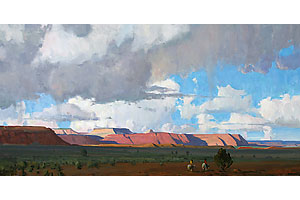 Gary Ernest Smith can often be found creating artworks in his Highland, Utah, studio, or out in the vast, open spaces.
Gary Ernest Smith can often be found creating artworks in his Highland, Utah, studio, or out in the vast, open spaces.
“I like the challenge,” Smith says of painting en plein air. “You can never anticipate a gust, a wind is going to come up, whether you’re going to be attacked by insects, which happens often, or how quickly the atmosphere changes by the clouds moving, the sun moving also, and you try to get the things in first that will change the fastest.”
Smith, who grew up on a cattle ranch in eastern Oregon, is inspired by artists like Maynard Dixon and Ernest Blumenschein. “Dixon’s paintings kind of have a symbolic quality about them, and I like to capture the same thing,” he says. “Almost iconic imagery.”
What he most enjoys about painting landscapes “is the sense of open space,” he says. “It has a man-against-nature feel to it.”
“I paint paintings that are based on the Western imagery,” he adds, “but it’s not a derisive cowboy and Indian kind of thing as much as it deals with the contemporary world we live in that is also the West, and we see it as the changing of the West—the evolution.”
When Smith approaches a Western subject, he says he wants to “get to the truth,” which he sometimes finds while touring historic sites. “One of my most meaningful trips was to go to Lincoln County, New Mexico, ‘Billy the Kid Country,’ with Bob Boze Bell and Ed Mell on a sketching/photography trip,” Smith says. “I love the history and seeing it firsthand.”
Of his Old West legends artworks, Smith says, “my figures in my paintings are mostly iconic, larger than life, where they represent the time and era, not just the person. There are times I have done specific paintings and bronzes that I try to get to the truth of their looks and dress.”
Wyatt Earp is among the icons Smith has sculpted (Kevin Costner and Kurt Russell, who both acted as Earp, own their own copy of that bronze). Even as a kid, Smith felt a connection to the O.K. Corral gunfighter: “Riding horses on a regular basis and living the Western life made Wyatt Earp and Billy the Kid that much more real to me.”
Although the artist is more drawn to landscapes these days, Smith says he still gets inspired to portray the history of the West. “The Old West,” he says, “its heroes along with the bad guys, continues to capture the imagination of a contemporary public.”
Up-and-Comers
 Smith is a fan of Jeff Pugh’s work that focuses on rural America. “He has a very bold and distinct, almost abstracted subject matter,” he says. In his paintings, Pugh often unites cattle to the landscape by using a palette knife to flatten the cows against the backdrop, as seen in Lunch Break.
Smith is a fan of Jeff Pugh’s work that focuses on rural America. “He has a very bold and distinct, almost abstracted subject matter,” he says. In his paintings, Pugh often unites cattle to the landscape by using a palette knife to flatten the cows against the backdrop, as seen in Lunch Break.
 He also likes G. Russell Case’s desert scenes. “They have a little bit of Edgar Payne, Maynard Dixon feel to them,” Smith says, “but they’re very vast, open space, red rock Arizona, Utah, and sometimes he’ll put little figures in them.” In Painted Cliffs, Case placed his pair of horseback riders in the shadows.
He also likes G. Russell Case’s desert scenes. “They have a little bit of Edgar Payne, Maynard Dixon feel to them,” Smith says, “but they’re very vast, open space, red rock Arizona, Utah, and sometimes he’ll put little figures in them.” In Painted Cliffs, Case placed his pair of horseback riders in the shadows.
{jathumbnail off images=”images/stories/Apr-2012/small/jeff_pugh_lunch_break.jpg,images/stories/Apr-2012/small/g_russell_case_painted_cliffs.jpg”}
Photo Gallery
Desert Solitude by Gary Ernest Smith.
– Courtesy Overland Gallery of Fine Art / Scottsdale, AZ–
– Courtesy Overland Gallery of Fine Art / Scottsdale, AZ –








